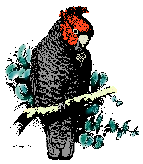I have seen the Night Parrot.
Now before all my esteemed and knowledgeable colleagues descend upon me,
no, I did not see it in Gungahlin and I have not reported it on Percival
Hill!
I saw them 46 years ago in the Northern Territory. Yes, I am reminiscing
again… But a few folk might find this interesting…
I was teaching in a remote Aboriginal community in the 1960s. One night I
was driving back after a weekend camping with two Aboriginal mates and living
off wild food. We had left the water hole and were on a rough track through
sandy spinifex country. Suddenly, two birds flew up in the headlights and one
struck the windscreen. My Aboriginal mates knew what they were. “Mirrlambing,
good tucker that one!” they said, leaping from the Landrover. Both birds flew
off into the spinifex but the one which had struck the windscreen was dazed and
a bit slower to take off and I had a good view of it in the lights. I knew I was
seeing the Night Parrot. I should have been more excited than I was. I knew
Night Parrots were supposed to be rare but I did not realise just how rarely
they were reported. We didn’t have the internet and Google back then. My
Bird Bible had been Cayley’s ‘What Bird is That?’ but it was mum’s book and
still back in Sydney with her.
My confidence in what I was seeing was to do with linguistics, not
ornithology. My deep interest has always been in Aboriginal languages and
indeed that was part of the reason for camping, to hear and learn informal
speech. The easiest Aboriginal words to collect are the names of things,
especially in the natural environment. I had already collected the word
‘Mirrlambing’ from Hickey, my old informant who reeled off bird names to me.
Hickey spoke 11 different Aboriginal languages and I never really knew
which language he named a bird in because he used the ‘proper’ name of the bird
that was appropriate to the bird’s own ‘country’. He only knew English
names for the commonest of birds and sometimes it took a long time for me to
identify the bird he named. I carried my notebook with me all the time, even in
school, and if we saw a bird I would ask the kids to name it and then find it on
my list, or sometimes add a new name. Mirrlambing had a blank next to it. I had
worked out from my informant that it was a green parrot and I had been
waiting to see one, not really conscious of its alleged rarity. He described it
as like a big Budgerigar but fatter so I knew what it wasn’t. I got Mum to mail
me Cayley’s book and I saw the picture again for myself. I showed my old friend
the pictures and he pointed to the Night Parrot. ‘Mirrlambing’ he said. All that
was well before that camping trip when we saw it but that’s what my mates had
called it in the Landrover - Mirrlambing. That’s how I knew what I was
seeing.
Some months later at home during the Christmas holidays, I thought it was
worth reporting to someone. I found out about the RAOU and wrote a letter. Well
they must have had an Unusual Birds Panel like COG has. They were not all that
interested but did reply saying that my sighting could not be verified and that
I was probably seeing a large Budgerigar. I don’t think it helped that I was a
very young man and someone they had never heard of.
When I went back after the school holidays, my mates told me they had
a few days before been on foot a long way out in the bush and had caught a
number of birds with their throwing-sticks drinking at a soak at dusk including
two Mirrlambing. They had cooked and eaten them. They used to just throw small
birds like that onto the coals. The feathers singed off and in just a few
minutes you could rake the birds from the fire and peel off the blackened skin
to eat the little bit of flesh. So I asked them to take me to the soak
which we did the following weekend. We saw no Mirrlambing drinking but we did
see some tail feathers near the soak where they had caught them. I didn’t bother
writing back to the RAOU. I was not very interested in officialdom at the time,
just happy in my own birdwatching as an interesting offshoot of my language
work. I kept the tail feathers for a long time with other feathers but
somewhere in the last 46 years I have lost them.
I know much more about Aboriginal languages now than I did then. When my
mates imitated the call of the night parrot, they made a squeaky high-pitched
sound like ‘irr-irr’, rolling the ‘rr’ . I would now say that the word
Mirrlambing could be analysed to mean the bird with the call like ‘irr’ or
‘irr-irr’.
I still have no interest really in proving anything to anyone, but I am
quietly pleased to be one of the few birders to have Mirrlambing on their
lifetime list – even if my list is only in my head!
Cheers
John

